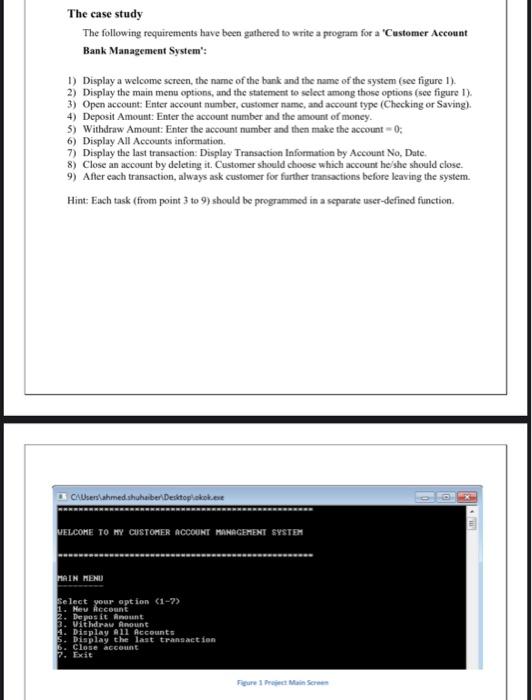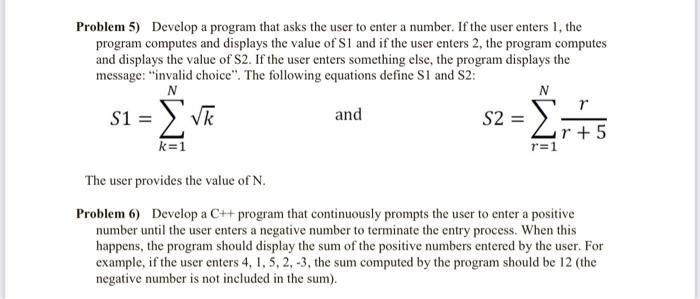The case study:
The following requirements have been gathered to write a program for a ‘Customer Account Bank Management System’:
1) Display a welcome screen, the name of the bank, and the name of the system (see figure 1).
2) Display the main menu options and the statement to select among those options (see figure 1).
3) Open account: Enter the account number, customer name, and account type (Checking or Saving).
4) Deposit Amount: Enter the account number and the amount of money.
5) Withdraw Amount: Enter the account number and then make the account = 0.
6) Display All Accounts information.
7) Display the last transaction: Display Transaction Information by Account No, Date.
8) Close an account by deleting it. The customer should choose which account he/she should close.
9) After each transaction, always ask the customer for further transactions before leaving the system.
Hint: Each task (from points 3 to 9) should be programmed in a separate user-defined function.

 25% off with code “SUMMER”
25% off with code “SUMMER”


![Please help me in the following code in Python The tspAnalyze.py is below: The tspTest_v0.txt and tspTest_v1.txt is:"The travelling salesman problem (also called the traveling salespersonproblem or TSP) asks the following question: 'Given a list of cities andthe distances between each pair of cities, what is the shortest possibleroute that visits each city exactly once and returns to the origin city?'It is an NP-hard problem in combinatorial optimization, important intheoretical computer science and operations research."- Wikipedia Contributors, "Travelling salesman problem",Wikipedia, The Free Encyclopedia, 10 October 2021.MAIN MENU0. Exit program1. Print database2. Limit dimension3. Plot one tourChoice (0-3)? 1NUM FILE NAME EDGE TYPE DIMENSION COMMENT 1 a280 EUC_2D 280 drilling problem (Ludwig) 2 ali535 GEO 535 535 Airports around the globe (Padberg/Rinaldi) 3 att48 ATT 48 48 capitals of the US (Padberg/Rinaldi) 4 att532 ATT 532 532-city problem (Padberg/Rinaldi) 5 bayg29 EXPLICIT 29 29 Cities in Bavaria, geographical distances (Groetschel,Juenger,Reinelt) 6 bays29 EXPLICIT 29 29 cities in Bavaria, street distances (Groetschel,Juenger,Reinelt) 7 berlin52 EUC_2D 52 52 locations in Berlin (Groetschel) 8 bier127 EUC_2D 127 127 Biergaerten in Augsburg (Juenger/Reinelt) 9 brazil58 EXPLICIT 58 58 cities in Brazil (Ferreira)10 brd14051 EUC_2D 14051 BR Deutschland in den Grenzen von 1989 (Bachem/Wottawa)11 brg180 EXPLICIT 180 Bridge tournament problem (Rinaldi)12 burma14 GEO 14 14-Staedte in Burma (Zaw Win)13 ch130 EUC_2D 130 130 city problem (Churritz)14 ch150 EUC_2D 150 150 city Problem (churritz)15 d1291 EUC_2D 1291 Drilling problem (Reinelt)16 d15112 EUC_2D 15112 Deutschland-Problem (A.Rohe)17 d1655 EUC_2D 1655 Drilling problem (Reinelt)18 d18512 EUC_2D 18512 Bundesrepublik Deutschland (mit Ex-DDR) (Bachem/Wottawa)19 d198 EUC_2D 198 Drilling problem (Reinelt)20 d2103 EUC_2D 2103 Drilling problem (Reinelt)21 d493 EUC_2D 493 Drilling problem (Reinelt)22 d657 EUC_2D 657 Drilling problem (Reinelt)23 dantzig42 EXPLICIT 42 42 cities (Dantzig)24 dsj1000 CEIL_2D 1000 Clustered random problem (Johnson)25 eil101 EUC_2D 101 101-city problem (Christofides/Eilon)26 eil51 EUC_2D 51 51-city problem (Christofides/Eilon)27 eil76 EUC_2D 76 76-city problem (Christofides/Eilon)28 fl1400 EUC_2D 1400 Drilling problem (Reinelt)29 fl1577 EUC_2D 1577 Drilling problem (Reinelt)30 fl3795 EUC_2D 3795 Drilling problem (Reinelt)31 fl417 EUC_2D 417 Drilling problem (Reinelt)32 fnl4461 EUC_2D 4461 Die 5 neuen Laender Deutschlands (Ex-DDR) (Bachem/Wottawa)33 fri26 EXPLICIT 26 26 Staedte (Fricker)34 gil262 EUC_2D 262 262-city problem (Gillet/Johnson)35 gr120 EXPLICIT 120 120 cities in Germany (Groetschel)36 gr137 GEO 137 America-Subproblem of 666-city TSP (Groetschel)37 gr17 EXPLICIT 17 17-city problem (Groetschel)38 gr202 GEO 202 Europe-Subproblem of 666-city TSP (Groetschel)39 gr21 EXPLICIT 21 21-city problem (Groetschel)40 gr229 GEO 229 Asia/Australia-Subproblem of 666-city TSP (Groetschel)41 gr24 EXPLICIT 24 24-city problem (Groetschel)42 gr431 GEO 431 Europe/Asia/Australia-Subproblem of 666-city TSP (Groetschel)43 gr48 EXPLICIT 48 48-city problem (Groetschel)44 gr666 GEO 666 666 cities around the world (Groetschel)45 gr96 GEO 96 Africa-Subproblem of 666-city TSP (Groetschel)46 hk48 EXPLICIT 48 48-city problem (Held/Karp)47 kroA100 EUC_2D 100 100-city problem A (Krolak/Felts/Nelson)48 kroA150 EUC_2D 150 150-city problem A (Krolak/Felts/Nelson)49 kroA200 EUC_2D 200 200-city problem A (Krolak/Felts/Nelson)50 kroB100 EUC_2D 100 100-city problem B (Krolak/Felts/Nelson)51 kroB150 EUC_2D 150 150-city problem B (Krolak/Felts/Nelson)52 kroB200 EUC_2D 200 200-city problem B (Krolak/Felts/Nelson)53 kroC100 EUC_2D 100 100-city problem C (Krolak/Felts/Nelson)54 kroD100 EUC_2D 100 100-city problem D (Krolak/Felts/Nelson)55 kroE100 EUC_2D 100 100-city problem E (Krolak/Felts/Nelson)56 lin105 EUC_2D 105 105-city problem (Subproblem of lin318)57 lin318 EUC_2D 318 318-city problem (Lin/Kernighan)58 lin318 EUC_2D 318 Original 318-city problem (Lin/Kernighan)59 nrw1379 EUC_2D 1379 1379 Orte in Nordrhein-Westfalen (Bachem/Wottawa)60 p654 EUC_2D 654 Drilling problem (Reinelt)61 pa561.tsp EXPLICIT 561 561-city problem (Kleinschmidt)62 pcb1173 EUC_2D 1173 Drilling problem (Juenger/Reinelt)63 pcb3038 EUC_2D 3038 Drilling problem (Junger/Reinelt)64 pcb442 EUC_2D 442 Drilling problem (Groetschel/Juenger/Reinelt)65 pla33810 CEIL_2D 33810 Programmed logic array (Johnson)66 pla7397 CEIL_2D 7397 Programmed logic array (Johnson)67 pla85900 CEIL_2D 85900 Programmed logic array (Johnson)68 pr1002 EUC_2D 1002 1002-city problem (Padberg/Rinaldi)69 pr107 EUC_2D 107 107-city problem (Padberg/Rinaldi)70 pr124 EUC_2D 124 124-city problem (Padberg/Rinaldi)71 pr136 EUC_2D 136 136-city problem (Padberg/Rinaldi)72 pr144 EUC_2D 144 144-city problem (Padberg/Rinaldi)73 pr152 EUC_2D 152 152-city problem (Padberg/Rinaldi)74 pr226 EUC_2D 226 226-city problem (Padberg/Rinaldi)75 pr2392 EUC_2D 2392 2392-city problem (Padberg/Rinaldi)76 pr264 EUC_2D 264 264-city problem (Padberg/Rinaldi)77 pr299 EUC_2D 299 299-city problem (Padberg/Rinaldi)78 pr439 EUC_2D 439 439-city problem (Padberg/Rinaldi)79 pr76 EUC_2D 76 76-city problem (Padberg/Rinaldi)80 rat195 EUC_2D 195 Rattled grid (Pulleyblank)81 rat575 EUC_2D 575 Rattled grid (Pulleyblank)82 rat783 EUC_2D 783 Rattled grid (Pulleyblank)83 rat99 EUC_2D 99 Rattled grid (Pulleyblank)84 rd100 EUC_2D 100 100-city random TSP (Reinelt)85 rd400 EUC_2D 400 400-city random TSP (Reinelt)86 rl11849 EUC_2D 11849 11849-city TSP (Reinelt)87 rl1304 EUC_2D 1304 1304-city TSP (Reinelt)88 rl1323 EUC_2D 1323 1323-city TSP (Reinelt)89 rl1889 EUC_2D 1889 1889-city TSP (Reinelt)90 rl5915 EUC_2D 5915 5915-city TSP (Reinelt)91 rl5934 EUC_2D 5934 5934-city TSP (Reinelt)92 si1032 EXPLICIT 1032 []93 si175 EXPLICIT 175 []94 si535 EXPLICIT 535 []95 st70 EUC_2D 70 70-city problem (Smith/Thompson)96 swiss42 EXPLICIT 42 42 Staedte Schweiz (Fricker)97 ts225 EUC_2D 225 225-city problem (Juenger,Raecke,Tschoecke)98 tsp225 EUC_2D 225 A TSP problem (Reinelt)99 u1060 EUC_2D 1060 Drilling problem problem (Reinelt)100 u1432 EUC_2D 1432 Drilling problem (Reinelt)101 u159 EUC_2D 159 Drilling problem (Reinelt)102 u1817 EUC_2D 1817 Drilling problem (Reinelt)103 u2152 EUC_2D 2152 Drilling problem (Reinelt)104 u2319 EUC_2D 2319 Drilling problem (Reinelt)105 u574 EUC_2D 574 Drilling problem (Reinelt)106 u724 EUC_2D 724 Drilling problem (Reinelt)107 ulysses16 GEO 16 Odyssey of Ulysses (Groetschel/Padberg)108 ulysses22 GEO 22 Odyssey of Ulysses (Groetschel/Padberg)109 usa13509 EUC_2D 13509 The file US.lat-long.Z can be found in the directory /doc/geography.110 vm1084 EUC_2D 1084 1084-city problem (Reinelt)111 vm1748 EUC_2D 1748 1784-city problem (Reinelt)MAIN MENU0. Exit program1. Print database2. Limit dimension3. Plot one tourChoice (0-3)? 3Number (EUC_2D)? 45Invalid (GEO)!!!MAIN MENU0. Exit program1. Print database2. Limit dimension3. Plot one tourChoice (0-3)? 3Number (EUC_2D)? 7See tspPlot.pngMAIN MENU0. Exit program1. Print database2. Limit dimension3. Plot one tourChoice (0-3)? 0](https://gotit-pro.com/wp-content/uploads/2023/10/688ee900-8844-48c6-a6ea-0ddfad7cd174.jpg)


![Large Integers Part #1 Largelnteger Class An array can be used to store large integers, one digit at a time. For example, the integer 1234 could be stored in the array num by setting num[0] to 1, num[1] to 2, num[2] to 3, num[3] to 4. However, for this class implementation, you might find it more useful to store the digits backward; that is, place 4 in num[0], 3 in num[1], 2 in num[2], and 1 in num[3]. For the sake of simplicity, we will be storing and manipulating only with positive large integers. Implement a class named Largelnteger that stores a large integer as an array of its digits. Class must extend HasState class (provided). This is needed to make sure clone() method is written correctly. Class must have the following: - Fields - Constant arraySize must be set to 23 - Partially filled array of integers of length 23 - int digitCount keeps the number of digits in large integer, e.t. how many elements of the partially filled array are used to store the number - No-argument constructor that stores number 0 in the array. Sets digitCount to 1 - Constructor that takes a string as a parameter. The constructor parses the given string and converts it into Large Integer by storing digits in the partially filled array. - Create a new custom Exception class called LargelntegerNumberFormatException. The constructor throws exceptions of this type when - string is too long to be stored as a 23-digit number or - when string is empty or - when the string contains non-digits and thus cannot be converted into a number. - Constructor that takes a number of type long as a parameter and builds an object from it by storing digits in an array. - This constructor also throws a custom LargelntegerNumberFormatException when a parameter passed to the constructor is a negative number. - getDigitCount() accessor to the digit count variable. - toString() method that converts an array into a string of numbers in the correct order. Number 12345 is converted into a string "12345" - add(Largelnteger) method that returns the sum of this integer and the one passed as a parameter. The method adds two large integers by implementing the usual "paper and pencil" addition algorithm. This is when the backward storage arrangement of those numbers in arrays will pay off. Carry-over will be easier to do when the integer is stored backward. - Create another custom Exception class called LargelntegerOverflowException. If the resulting number is more than 23 digits long, the add() method throws a LargelntegerOverflowException type exception. - Implement clone() method. - Make your class implement Relatable interface. Code of the interface is provided. Implement all three methods of the Relatable interface. Part #2 Polymorphic Class This class exists only to house one static method called isSorted(). The method must take an array of objects of type Relatable and check if the array is sorted with the help of methods of Relatable interface. The method returns true if the array is sorted and false if it is not. The whole purpose of this exercise is to illustrate the concept of polymorphism. The purpose of this class is to house three static methods. 1. Method void writeLargelntegerArray(Largelnteger[], String) takes an array of Large Integers and a name of a file as parameters. The method writes the contents of the given array into the given binary file (in binary mode). The method throws IOExceptions. The IOExceptions may originate in the methods but must not be handled. Instead, they must be propagated to the calling code. - Make sure to add implements Serializable to the Largelnteger class header. Binary IO will fail to work without that. 2. Method Largelnteger[] readLargelntegerArray(String) method reads the contents of a binary file with the given name as an array of objects of type Largelnteger. Assume you do not know the amount of data in the file. Read data one Largelnteger object at a time and store the objects in ArrayList first. After the end of the file has been reached, convert the ArrayList into a regular array of objects that can be returned from the method. - Please study EOFDemo.java code example to learn how to use exceptions when checking for the end of the file while reading from a binary file. - This method also throws IOExceptions. The IOExceptions may originate in the methods but must not be handled. Instead, they must be propagated to the calling code. 3. Method Largelnteger addLargelntegersFromFile(String) takes a text file name as a parameter. It reads an arbitrary number of strings of text from the file, converting them into Largelntegers as it reads. The Large Integers are added one by one to the running total with the help of add() method. The sum of all the Large Integers stored in the file as strings is then returned from the method. - The structure of the file may be imperfect. Some strings may contain corrupted data and will fail to be converted into Largelnteger. This must not interrupt the process of reading from the file. The corrupted string must be skipped over, and the next string must be read and converted. Use a try/catch block to catch and ignore LargelntegerNumberFormatException. - The sum of all numbers stored in the file may become too big to be stored in a Large Integer. In that case, a LargeIntegerOverflowException exception will be thrown by the add() method. If this happens, catch the exception and return a null value from the method. - This method also throws IOExceptions. The IOExceptions may originate in the methods but must not be handled. Instead, they must be propagated to the calling code.](https://gotit-pro.com/wp-content/uploads/2023/10/a2443259-5cf9-45ff-9909-fdcfa036711f.png)
![(b) Modify the program in Q3(a), with the following new rules: - Players will need to win 3 games to become the overall winner. - Implement a penalty - for the player who skipped, entered an incorrect expression, or entered an expression that evaluated to the wrong result, will draw 2 random digits into their hand. - The player who loses the game will be awarded a "Skip" card in the next game. With the "Skip" card, the player can hit < Enter > to skip, without a penalty. - If not utilized, the "Skip" cards CANNOT be carried forward to the next game. Illustration of the "new" game on the left column, with the rules of the game explained on the right column: Enter player: Alan Enter player: Betty Enter player: Starting hand (number) of digits: 4 Let's play... Game 1 Round 1: Result 6 Betty's hand: [5,2,1,1] Enter expression: 5+1 Correct! Betty's hand: [2,1] Alan wins this game in 4 rounds!! Overall game score: Alan 1, Betty 0 Let's play... Game 2 Round 1: Result 5 Betty's hand: [3, 6, 5, 7, 'S'] Enter expression: Skipped with no penalty!! Betty's hand: [3,6,5,7] Alan's hand: [2,1,2,1] Enter expression: Skipped and 2 digits added to hand Alan's hand: [2,1,2,1,4,7] Betty wins this game in 5 rounds!! Overall game score: Alan 1, Betty 1 Let's play... Game 3 Round 1: Result 6 Betty's hand: [1, 2, 8, 7] Enter expression: 8-2 Correct! Betty's hand: [1, 7] Computer randomized the play sequence and will stay the same for every game/round End of game, if no overall winner, continue to play another game. Loser will be awarded a "Skip" card in the next game. "S" represents the "Skip" card awarded to Betty. No penalty for Betty as she has a "Skip" card. Hit < Enter > key to skip if cannot form an expression. In this case, the player who skipped will draw 2 random digits into their hand. End of game, if no overall winner, continue to play another game. Loser will be awarded a "Skip" card in the next game.](https://gotit-pro.com/wp-content/uploads/2023/10/1fa83cc6-5755-4d51-b5f6-f4335b49f1c8.jpg)
![(1) Write a function which takes a list of the coefficients of a polynomial P(x) = a0 + a1x + a2x^2 + ... + anx^n of arbitrary degree n, and a value of x0, and returns P(x0). You can use the function given in lectures, ensuring you understand how it works. (2) Use the function to evaluate (a) P1(x) = 4x^4 + 3x^2 + 2 at x = 2. (b) P2(x) = 241x^4 at x = 2. Are these answers exact? Explain why or why not. (Use a print statement to show the evaluation of your function, and answer the question in a comment.) (3) The power series for the sine function sin(x) is given by sin(x) = Σ (1)^n * (2n+1)! * x^(2n+1) = x - x^3/3! + x^5/5! - x^7/7! + ..., for all x. Use the first four terms in this series in the Horner evaluation function at a suitable value of x to give an approximation of sin(π/4). (4) (a) Use your Horner's method function to evaluate the polynomial (x-1)^3 at the point x = 1.000001. (b) Is this answer correct? (c) Briefly explain why or why not. (5) In week 3 we wrote a function to convert from binary to decimal. This can be adapted to other bases; here we will explore octal (base 8). The efficiency of the function we wrote can be improved using the same principle as Horner's method. Write such a function (horner_octal_to_dec) using the ideas of Horner's method which takes a list whose entries are integers between 0 and 7, where the list represents a base-8 number, and returns the corresponding decimal integer (so the input [2,5,1] returns the integer 169).](https://gotit-pro.com/wp-content/uploads/2023/10/627bbfd5-a1bb-4d60-954c-b70c3537706b.jpg)


Frank Cory –
Great Work In Timely Fashion. Something what I wanted.
Nitin Desai –
Fantastic support for every assignment, every time. 5+ Stars!
Glenn Mccall –
It was quality work and in a timely manner. It was the help I needed at the time, and I appreciate it so very much.
Andrew Porteck –
I have received phenomenal service that is consistent. The quality of work is A+ and the prices are very reasonable.